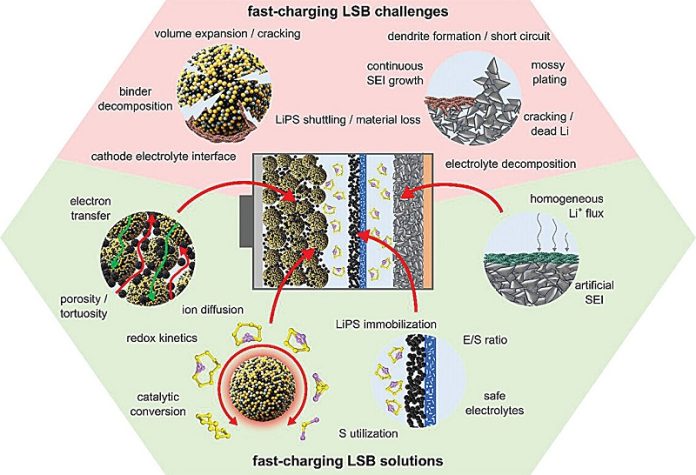
Imagine plugging in your electric car, grabbing a coffee, and coming back to a fully charged vehicle in just 12 minutes.
That’s the future scientists are working toward, and a new international study has outlined how lithium–sulfur batteries (LSBs) could make it possible.
Published in Advanced Energy Materials, the review study was led by researchers from Germany, India, and Taiwan, coordinated by Dr. Mozaffar Abdollahifar at Kiel University in Germany.
The team analyzed hundreds of recent studies to identify key materials and technologies that could help lithium–sulfur batteries charge much faster than today’s lithium-ion batteries—without sacrificing safety or battery life.
Lithium–sulfur batteries have long been considered a promising alternative to conventional batteries.
Instead of storing energy in solid materials like lithium-ion batteries do, LSBs use chemical reactions between lithium and sulfur.
This approach could theoretically deliver about 10 times more energy, meaning electric vehicles could travel much farther on a single charge. Sulfur also has other advantages: it’s cheap, easy to find, non-toxic, and environmentally friendly.
But there are still challenges to overcome. Sulfur doesn’t conduct electricity well, so it must be mixed with other materials, which can make batteries heavier. During charging and discharging, the sulfur side of the battery expands by up to 80%, which can damage the battery over time.
A major problem is the “shuttle effect”—a process where unstable chemical compounds formed during battery use migrate and cause efficiency loss and possible damage.
Additionally, dangerous needle-like structures called dendrites can grow on the lithium anode, increasing the risk of short circuits and fires.
To address these problems, researchers looked at successful strategies used in recent fast-charging battery experiments.
These include designing cathodes with special carbon materials to improve how ions move, using catalysts to speed up reactions and prevent chemical buildup, and creating better separators and electrolyte mixtures to stop unwanted side effects.
They’re also testing new forms of sulfur and protective coatings for battery parts, all with the goal of making LSBs safer, lighter, and more powerful.
Excitingly, some experimental batteries have already shown they can charge in under 30 minutes while maintaining strong performance. But more work is needed to increase the amount of energy each battery can hold if they are to truly surpass lithium-ion batteries in everyday use.
The study offers a clear, science-based roadmap for developing fast-charging lithium–sulfur batteries, blending expertise from chemistry, materials science, and engineering.
With continued research and smart design—possibly aided by artificial intelligence—these next-generation batteries could soon power everything from electric vehicles to large-scale energy storage, transforming how we charge and use electricity.
Source: KSR.



